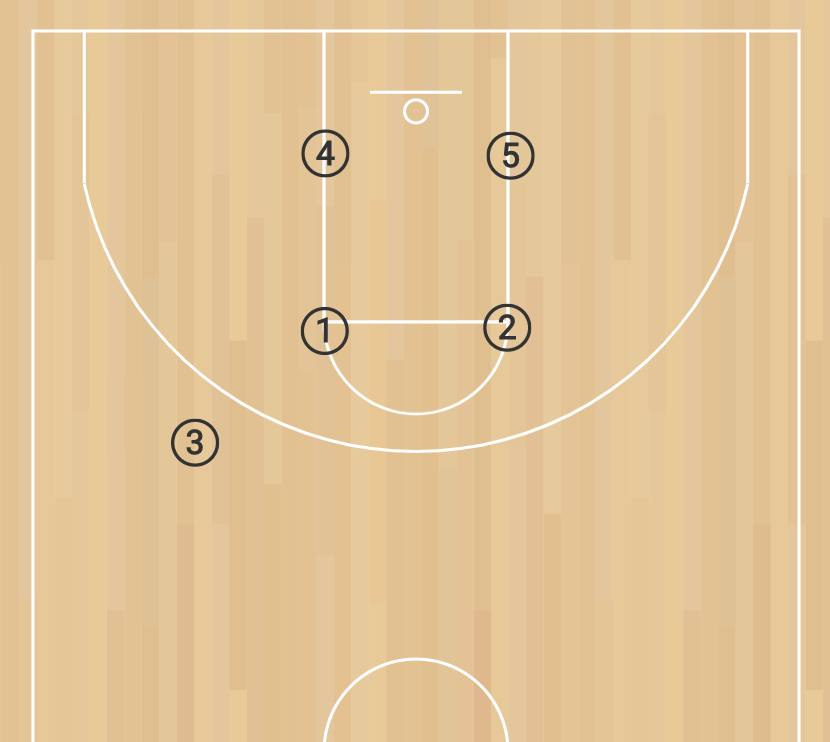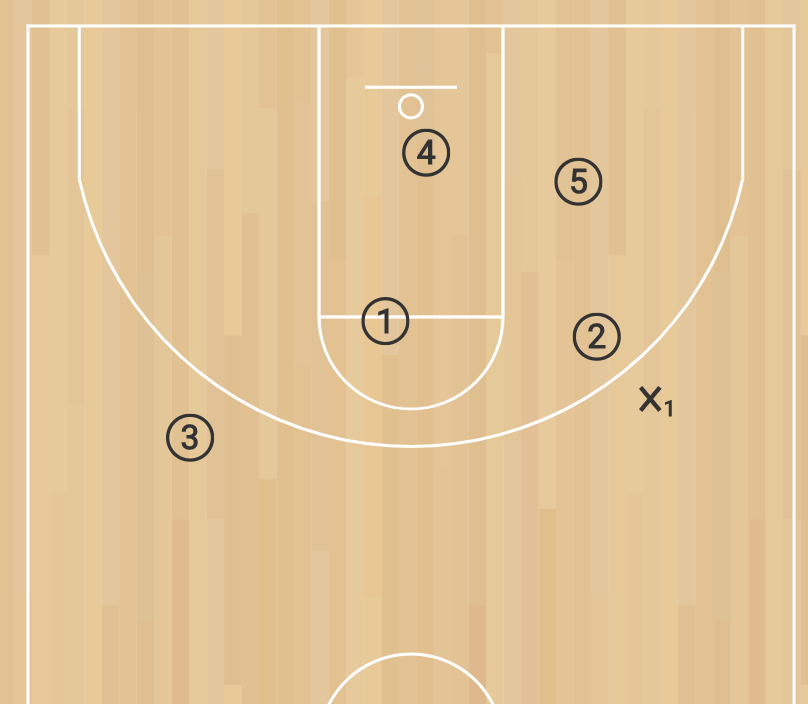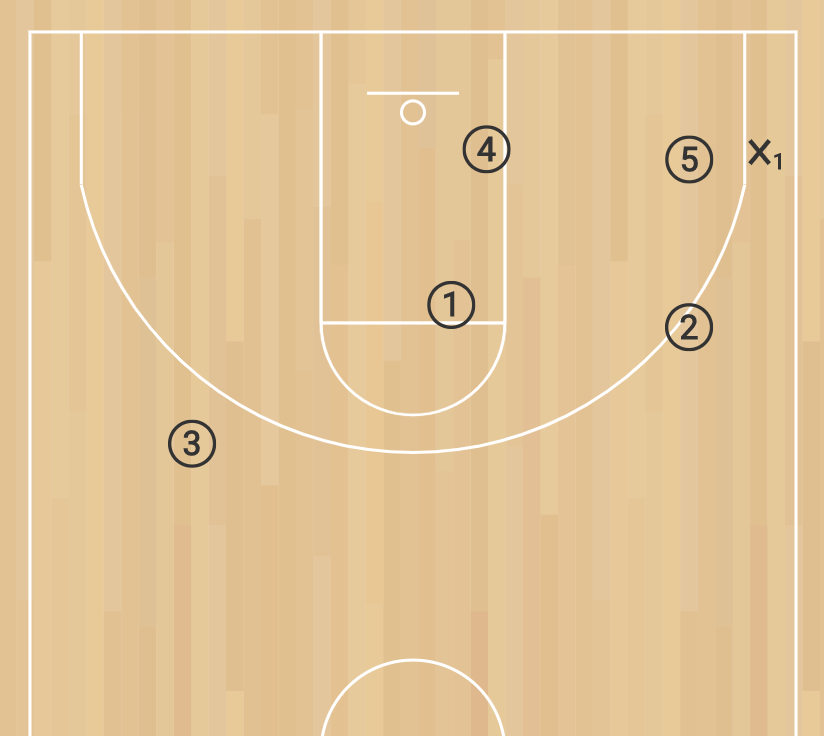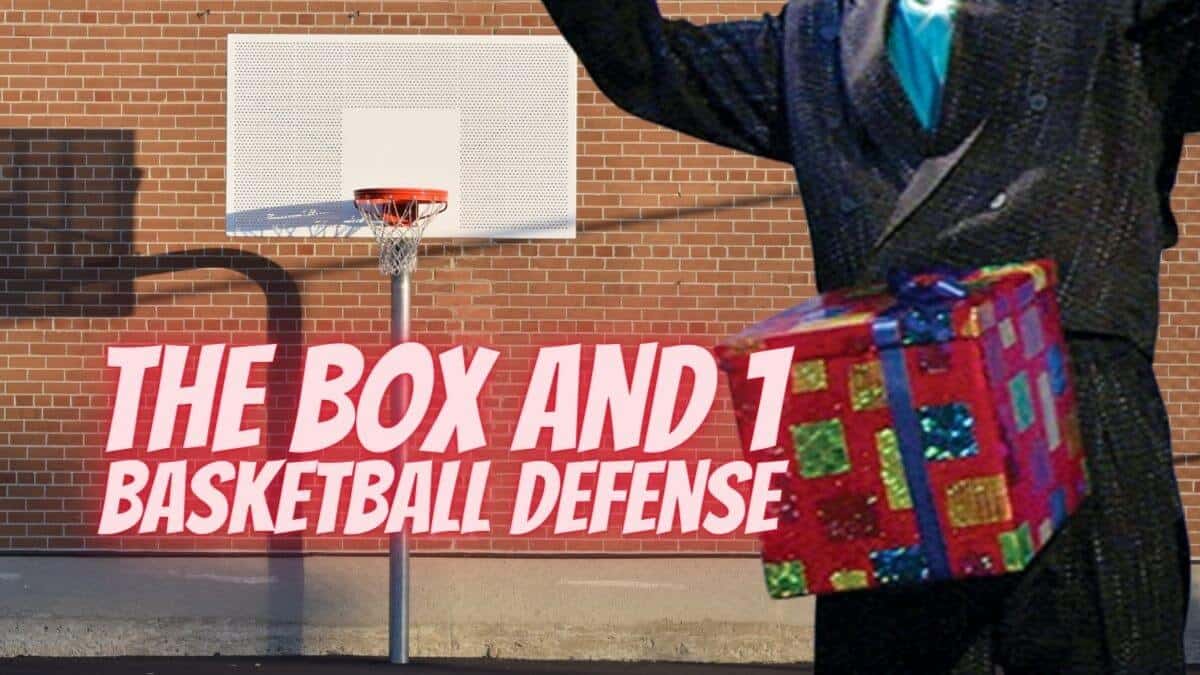The box and 1 defense is a defensive strategy in basketball. You set up 4 of your players in a zone, leaving one player (probably your quickest) to float. This can be great for isolating an opponent’s best player. This combo of man-to-man and zone defenses means the box and 1 is classified as a ‘junk’ defense.
We’ll go deeper here though. If you’re just casually curious, click down to check out some of the more interesting examples of the box and 1, like the time the Raptors used it to win a title 😮. But for coaches and players, we’ll also cover some steps and counters so you can work the box and 1 defense into your toolkit.
What is a box and 1 defense and how does it work?
With the box and 1 defense, one defender is assigned to guard a specific player while the other four defenders play a zone defense. The four defenders form a ‘box’ around the paint, the fifth defender floats around as the ‘and 1’.
This strategy comes up a lot when there’s one elite player on a team that’s a challenge to isolate.. With a designated defender guarding the best player on the offense, the remaining players concentrate on the paint.
So you’re matching a strong deterrent against drives with some perimeter isolation. But more importantly, that star player on the opposing team is pressured into taking deeper shots that are also probably well-contested. If they do head into the paint, they’re going to hit a lot of traffic.
Implementing the Box and 1 Defense
The Initial Formation

This one is simple. Your bigs go under the basket. Your guards or wings go at the corners near the free throw. Whoever is matched up with that super good opposing player gets to go out and attack that matchup.
Roles
In addition to separating a single defender for man-to-man coverage, the zone defenders can be split into two groups in terms of responsibilities. Low defenders play the post. High defenders play the top of the paint.
Floater or Chaser
The main goal of the chaser is to make it difficult for the star player to get the ball and score. This player works to deny their matchup the ball.
Helping and rotating on defense are not as high a priority, but they should factor in to this players thinking. The further the ball is away from your man, the more you can help. The quicker you are, the more you can help.
The chaser should be a smart and hardworking defender, but they also need to be disciplined. If their matchup gets frustrated and resorts to physical or verbal tactics to throw the chaser off their game, they have to be able to maintain composure and continue to defend effectively.
The Low Defenders
The low defenders in a box and 1 basketball defense are responsible for defending the post and the corner. The strong side defender should stay prepared to front the post. But you also need to stay ready on the weak-side. Additionally, the post players should always be aggressive when going for rebounds unless contesting a shot.
The High Defenders
The high box defenders originate at the top of the paint. They are responsible for preventing the ball from getting into the high post and defending the perimeter on their side of the court.
The high defenders need to cover a lot of ground, so they should be quick and effective on-ball defenders. When a shot is taken, the weak-side high box defender should be going hard after rebounds.
Rotations
We already know where that floating defender is going to be; everywhere. So let’s focus a little more on those center 4. How should your zone adjust to the ball?
This is a little more simple than your average defensive rotation system. It’s actually pretty simple to just describe the entire rotation strategy as simply moving towards the ball. The nearest defender closes out. The remaining defenders shift to the strong side.
Run the shell drill. This is a great drill overall, but for the box and 1, it’s perfect. You get your crew running through these simple transitions aggressively and it starts to look very smooth. And it reinforces the idea of thinking in terms of how many passes away from the ball you are as a defender.
Ball on the Wing
The top defender closes out. The weak-side low defender takes over the post to give the strong-side a little room to isolate the corner. The weak-side high defender is basically responsible for the rest of the court, doing their best to cut off passing to the weak side.

Ball in the Corner
If the ball makes it to the corner, now the low defender needs to close out. The weak-side low defender should be fronting the paint now, especially in leagues where you have a limit on time in the paint (most leagues?). The high defender on that side cuts off backwards travel. The high defender on the weak side keeps that same job, guarding passes across the floor.

When to use a Box and 1 Defense
The box and 1 defense is typically used when the opposing team has one dominant scorer who is difficult to stop with a regular zone or man-to-man defense. By putting one defender on the opposing team’s best player, the defense can limit their scoring opportunities and force the other players to step up and contribute.
If the opposing team doesn’t have a strong outside shooter, this can be great. You’ve got probably your quickest and best defender distracted and the rest of the team in the paint. This leaves space around the arc to pick up open shots.
And this is why you don’t see this tactic often at the college or professional levels. It’s just not that common for a team to not have a secondary shooter who can take advantage of this weakness.
To summarize…
Advantages
- Slow down a dominant scorer on the opposing team and sap their energy.
- Create confusion for the opposing team
- Force other players on the opposing team to take on larger offensive roles.
Disadvantages
- It can be difficult to execute, requiring strong communication and coordination.
- Leaves other players wide open, especially on the perimeter.
How to Beat a Box and 1 Defense
Let’s run through some tips to counter the box and 1 defense as a coach:
- Focus on your team’s strengths: The box and 1 defense is designed to take away one player, so it’s important to put your other players to work. Try some screens and pick and rolls to free up other players and create scoring opportunities.
- Move the ball: Ball movement is key to breaking down the box and 1 defense. Encourage your players to pass the ball quickly and find open teammates. This will force the defense to adjust and create gaps in their coverage.
- Practice against the box and 1: Practice is crucial when it comes to countering the box and 1 defense. Set up drills that simulate the defense and allow your team to practice breaking it down. This will build confidence and help players recognize the defense’s strengths and weaknesses.
Put all of these together and you’ll make the box and 1 look like a joke.
The History of the Box and 1 Defense
I’d love to know the origin story of this defense, it’s so interesting and most certainly developed around some interesting players. But it’s going to take some serious research to get there, so for now I’m just focusing on a certain notable application of this strategy…
Probably the most notable application fo the box and 1 defense came in the 2019 NBA finals. The Toronto Raptors, facing down Steph Curry and the Golden State Warriors, sent Fred VanVleet to hound Curry to crazy effect. The Warriors were missing both KD and Klay Thompson
You gotta watch a couple of possessions from this series if you haven’t seen this before. It’s pretty entertaining to watch VanVleet chasing Curry in and out through coverage.
Box and 1 Drills
A few drills you can run with your team to work on learning and implementing the box and 1:
The Shell Drill
Ever played Zoom Schwartz?
Get 4 players into a zone around the paint. Get another 4 players standing around the perimeter. The perimeter players pass to each other. The defenders shift with the ball.
If you’re on the ball, you yell ‘ball’. If you’re one pass away, you yell ‘deny’. If you’re two passes away, you yell ‘help’.
This is a fantastic defensive drill overall, but it’s particularly good for getting that 4-defender zone functioning and communicating effectively.
Screen Escaper
Setup some cones in the paint in the formation of a 2-1-2 zone, 1 cone in the center and 4 more in a box around it.
Divide your players into 1’s and 2’s. Match one player of each type and run them through the cones on the whistle. The 1 should use the cone as they would a screen, trying to escape 2’s coverage.
The 1 is trying to fake out the defender and screen off the cone. This is great practice for the quickness you need to maintain or escape a box and 1 defense.
Suicides
Less of a drill, more of a grind to get your conditioning rock solid to maintain the quickness needed in this strategy. If you need a competitive angle, run your players against each other back and forth across the paint. The winner gets to take a break.
Conclusion
A Box and 1 is a distinct maneuver that can be exciting to watch. It can also be a very helpful little tool to have in your team’s kit.
Remember to emphasize communication and teamwork when practicing the box and 1 defense. It’s essential that all players understand their roles and responsibilities and work together to shut down the opposing team’s offense.
.
